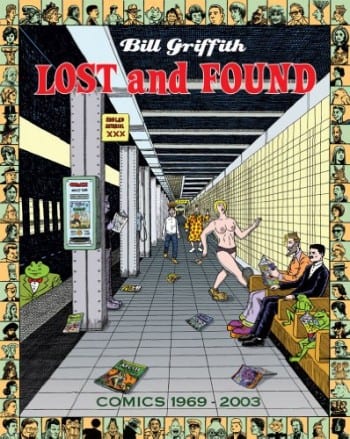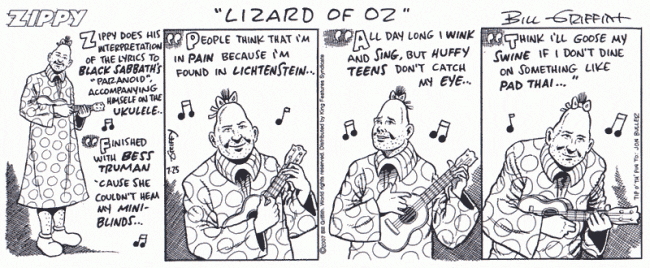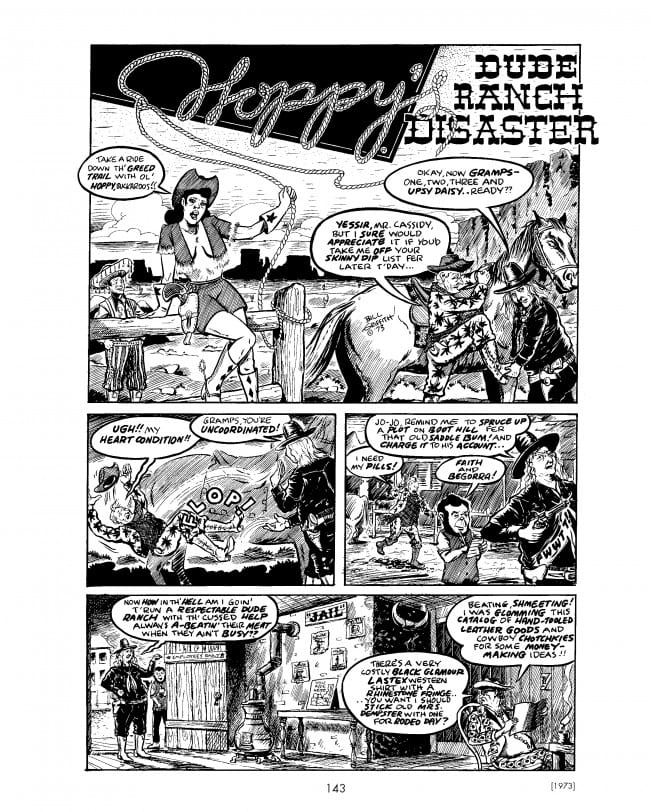 Bill Griffith's 362-page collection, Lost and Found: Comics 1969-2003, was published earlier this year. It is exactly what you might think: A massive collection of the cartoonist's stories. Griffith is well known for Zippy, but this new book repositions him as a key underground cartoonist as well by rescuing his stories from anthologies, magazines, and long-out-of-print comic books. Tim and I were both dumbfounded by the sheer quantity of great stories in this volume, so we asked Gary Panter, a longtime Griffith fan and friend, to interview the artist. The two corresponded via email. All images courtesy Bill Griffith. —DN
Bill Griffith's 362-page collection, Lost and Found: Comics 1969-2003, was published earlier this year. It is exactly what you might think: A massive collection of the cartoonist's stories. Griffith is well known for Zippy, but this new book repositions him as a key underground cartoonist as well by rescuing his stories from anthologies, magazines, and long-out-of-print comic books. Tim and I were both dumbfounded by the sheer quantity of great stories in this volume, so we asked Gary Panter, a longtime Griffith fan and friend, to interview the artist. The two corresponded via email. All images courtesy Bill Griffith. —DN
PANTER: Are you a first- or second-generation hippie underground cartoonist?
GRIFFITH: First, I guess. I started doing comics in the underground press in New York in the late '60s--Screw, East Village Other, Gothic Blimp Works, New York Ace. Hippie? Me? I would never join a group that would have me as a member.
PANTER: The Zap guys seem less scary than Griffith/Green/Lynch/Deitch/Spieg crowd to me. Does that seem true?
GRIFFITH: Is scary a good thing? The only thing that was scary to me when I arrived in San Francisco in 1970 was S. Clay Wilson--both himself and his comics. Then again, my main character in the early years was a very scary, large amphibian named Mr. The Toad. I would dream of him waiting on my doorstep when I came home, holding a baseball bat. Scary in a menacing, mind-game kind of a way.
PANTER: I've asked you about Griffy's hair, but for the record...?
GRIFFITH:The Griffy hairdo began as an exaggerated cowlick in my first Griffith Observatory strips for the Berkeley Barb in 1976. My actual hair was kind of long in those days and I would wake up with much of it standing up straight. I thought that was funny, so I gave it to Griffy, my alter ego. As with almost all cartoon character traits, it got more and more exaggerated the more I drew it, eventually threatening to crowd out precious space for word balloons at the top of panels. In 1990, in a Zippy daily strip, Griffy realizes there's not much he can control in his life, but he can control his hair. He combs it flat--and from then on, he has only a medium-size pompadour.
PANTER: What was the line even Mr. Toad wouldn't cross?
GRIFFITH: I don't think there was one. In at least one really early Mr. Toad story, he commits murder. He was also a misogynist and a sadist. But he's changed more than most of my characters. Today, he's more likely to commit mind manipulation than homicide. There were three issues of my Tales of Toad comic from 1970 to 73. Some day, I want to do number four. As much as I like doing Zippy, there are moments when I think my best character is Mr. The Toad. Anyway, he told me to say that. And he's still holding that baseball bat.

PANTER: More than any other social critic, you pegged '70s fashion extremes and nostalgia ahead of the pack. What it is your willingness to look into scary places that put you ahead of the pack?
GRIFFITH:What's with the "scary places"? I'm a fun guy.
I still think the 1970s "Eleganza" look was both the high and low point in men's fashions and provided great visuals for a cartoonist to play with. I remember thinking how hilarious it was that such clownish clothes were supposed to be taken seriously. I'm talking about the kind of duds you'd see on the Soul Train TV dance show or on that wonderful time capsule of a movie, Saturday Night Fever. Or on Market Street in San Francisco on a really good day. In my current strips, Claude still wears the bell bottoms and huge collars of his formative, redneck disco days. He doesn't change, learn, or grow, although he does get more bitter.

PANTER: Sometimes early on, your little detective guys look like Spiegelman could've drawn them. What's up with that?
GRIFFITH: "Little detective guys"? Don't know what you mean. Maybe my "Detective Zippy" story in Arcade #1 in which Spiegelman put in a cameo with his "Ace Hole" detective character?
 PANTER: Some of your wildest comics were drawn in 1972. Was that a free love acid year for you or what?
PANTER: Some of your wildest comics were drawn in 1972. Was that a free love acid year for you or what?
GRIFFITH: I've only taken LSD twice in my life. Once on the beach in Martha's Vineyard in 1967, which was pleasant, but not ego-shattering or anything. And once in New York after I'd started doing comics. All I remember about the second time was, I got hemorrhoids. I did smoke my share of weed in the early '70s--but aside from a few embarrassingly adolescent surreal pages I did for the East Village Other while high, I didn't use pot when I worked.
My eccentricities and non sequiturs just seem to come naturally.
PANTER: Still playing the guitar? If so, do you play tunes or noodle? What might be a favored tune?
GRIFFITH: I'm more into my ukulele these days. I always treated the guitar as an instrument of relaxation and pleasure--something I'd do after work. But the ukulele releases me from the tendency to compare my skills with professionals--it's so much more user-friendly. I can sit down and toy with it for a half hour or so at a time without ever feeling like I should be a better player than I am. I used to think if Zippy were to play a musical instrument, it would be the baritone sax. But now I picture him playing the ukulele--it's pure fun. In fact, I've even done a handful of strips with Zippy and his uke. Recently, I learned "Not Fade Away" by Buddy Holly.
 PANTER: Do you work in silence or with music or something? What would be spinning on your turntable? Do you still have a turntable?
PANTER: Do you work in silence or with music or something? What would be spinning on your turntable? Do you still have a turntable?
GRIFFITH: No turntable any more. CDs or NPR. Occasionally YouTube. I divide my work day into two periods: thinking and inking. When I'm trying to get an idea, or when I'm writing a strip, I need silence. Luckily, here in the Connecticut woods, there's plenty of that. When I'm inking, I either have NPR going on the radio or a music CD. I'm pretty all over the map with my musical tastes. Buddy Holly, Charles Ives, Bob Dylan, Muddy Waters, Chet Baker, Mozart. I even like Adele. I also periodically dip into the cassettes Robert Crumb made for me from his 78 collection years ago. I really should get them transferred to CDs before they give out.
PANTER: When I have visited there is a tremendous ink spot in the area to the left (I think) of your desk where you flick excess ink. How big is the spot now? How dark?
GRIFFITH: I have a drawer permanently pulled out from my big oak drafting to the right of where I sit. The drawer contains all my pens, ink, white-out and water bottles for cleaning pens and brushes. Every time I dip my Hunt 100 nib into the inkwell, I flick it to remove excess ink. Same with my white-out brush. Those black and white flicks have now completely covered the surface of the drawer, all the bottles in the drawer and a good portion of the floor below the drawer. Some people have asserted that it looks "weird" or even "creepy." I think it looks like a pretty good 3-D Jackson Pollock painting.
PANTER: Do you remember a recent dream? Since your free association practice is vaguely dream related, do you use dream material in Zippy?
GRIFFITH: Not really. Although I do occasionally have an idea for a Zippy strip just as I'm waking up, in that "Twilight Zone" between sleep and wakefulness.
A lot of my ideas come to me while I'm on my morning walk. I walk about a mile around a nearby place called Gillette Castle. It's the eccentric residence of actor William Gillette (1853-1937), whose claim to fame is his portrayal of Sherlock Holmes on stage in the early 1900s. The nice thing is that since the walk takes about forty minutes I can flesh out a whole strip in my mind, panel by panel, then write it down in my notebook before I get back to my studio. There is a dream-like quality in the way Zippy strips come to me. It seems I'm "receiving" them, like a radio signal---no, not through the fillings in my teeth--not yet, anyway. But in some less than rational way, certainly. I've learned to just let these thoughts come without judging them. The little editor inside my head deals with that part later.

PANTER: Your western comic "Hoppy's Dude Ranch Disaster" was a masterpiece of the cartoon art form -- any plans to visit the old west again?
GRIFFITH: That's actually one of my favorite stories of all the work I've done. I was a big fan of the Hopalong Cassidy TV show as a kid in the '50s. William Boyd, the actor who played Hoppy, came to Levittown on some sort of promo tour at the height of the show's popularity in 1954. Along with all the other kids, I stared in horror at this old guy with white hair tilting precipitously on his horse in front of May's Department Store on Hempstead Turnpike.
In the movies, he looked much younger--and I figured his hair was blond in the black and white footage. I had no way of knowing the Hoppy series I was watching on TV had been made decades before as two-reelers to fill out a movie theater's double bill. The Hoppy in "Dude Ranch Disaster" is my exaggerated take on how Hoppy would act if he'd kept up the persona well into old age. I still don't know why I teamed him up with a stereotypical Irish caricature of a sidekick, but it seemed to work.
At the end of the tale, the Lone Ranger is seen exposing himself high on a hill. I've used the Masked Man in Zippy strips over the years, including a long-running series from November of 2004 where the Lone Ranger tries to help Zippy in his run for the Oval Office.
 PANTER: Do you ever watch Ghost Hunters on the TV in a hotel room? Do you get the creeps or are you brave?
PANTER: Do you ever watch Ghost Hunters on the TV in a hotel room? Do you get the creeps or are you brave?
GRIFFITH: Funny that you should mention Muffler Men. As you know, Zippy has been on a prolonged road trip around the United States, off and on, for years, visiting every Muffler Man, giant bowling pin, and Big Duck from Maine to New Mexico.
 PANTER: Did you get to San Francisco in time for free love and get to act like a democrat back in the '60s? Was it embarrassing or righteous?
PANTER: Did you get to San Francisco in time for free love and get to act like a democrat back in the '60s? Was it embarrassing or righteous?
GRIFFITH: Funny that you should mention Dingburg, the city inhabited entirely by pinheads. A few years ago, I began to expand Zippy's circle of friends in the daily strip beyond my usual cast of characters to a wider world of other people like Zippy--other pinheads. I kept this up for a few months, happily adding more and more muu muu-clad men and women until one day the whole thing just reached "critical mass."
The thought then occurred, "Where do all these friends of Zippy live? Do they live in the 'real world,' which Zippy has been seen escaping into for years--or do they live apart, in a pinhead world of their own?"
Thus, Dingburg, "The City Inhabited Entirely by Pinheads," was born. It even had a motto: "Going too far is half the pleasure of not getting anywhere." The logical next step was to imagine Dingburg streets and neighborhoods---to create a place where Zippy's wacky "rules" would be the norm and everyone would play 24-hour Skee-Ball and worship at the feet of giant Muffler Men.
Zippy had, at last, come home.
 PANTER: Did you ever own a pair of Earth Shoes?
PANTER: Did you ever own a pair of Earth Shoes?
GRIFFITH: Funny that you should mention all those men you see these days with shaved heads, a goatee, and one earring. Do I really need to see one more rear neck fold? Also, what's with the current craze for rectangular eyeglass frames? Get oval.
PANTER: Five favorite comic books as a kid? Newspaper strips?
GRIFFITH: Comic books: Plastic Man, Walt Disney's Comics and Stories (only for Uncle Scrooge and Gyro Gearloose), Little Max (spin-off character from "Joe Palooka" by Ham Fisher), the first twenty-four Kurtzman Mads, and Mighty Mouse (especially in 3-D).
Newspaper strips I read as a kid: Nancy, Louie (a silent strip by Harry Hanan), Dick Tracy, There Oughta Be A Law!, and Alley Oop.
PANTER: What nib do you use and do you have a bunch left?
GRIFFITH: A number of years ago, I was perusing the pens at the Art Brown International Pen Shop in midtown Manhattan, when I saw a sign saying there were sale items upstairs. I'd never noticed there was second level to the store. Among the discontinued items up there were boxes of Hunt 100 nibs. I picked one up, trembling, and noticed they were obviously old stock from the 1950s. I bought every box. I'm still using them and I expect they may last me the rest of my life. As anyone will tell you, nib quality has taken a nosedive over the years. Gillotts sometime last barely beyond one use. But these old Hunts are real workhorses. And still incredibly flexible. Those and my Rapidograph .025 and .035 are all I need, ink-wise.
PANTER: A book we should read?
GRIFFITH: The Walt and Skeezix series of Gasoline Alley strips by Frank King, published by Drawn & Quarterly. Reads like a graphic novel you never want to end.
PANTER: Cruikshank, Gillray, or Grandville?
GRIFFITH: Gillray's my favorite of those three. But you left out Thomas Rowlandson, whose work I also hold in high regard, right up there with Gillray. He was a little less grotesque than Gillray, but just as fun to look at and read. These guys were, of course, the fathers of modern day comics. I love the way word balloons emitted from the mouths of their people and went up at odd angles, the writing all crammed in. It took over a century for word balloons to float to the top of panels and be lettered on line with the horizontal lines of the panel borders.
Gillray was an acknowledged hero of Harvey Kurtzman--you can detect his influence on the early Mad magazine sensibility, with its transgressive skewering of every social fad and foible.
PANTER: Though you can draw in any style you have a distinct gravity pulling you towards Griffithism. What is at the core of that magnetism?
GRIFFITH: What am I working on now? Funny you should ask. After decades of simmering on the far back burner, I've finally started on my graphic novel. It's a memoir whose central focus is the secret fifteen-year affair my mother carried on with a famous cartoonist and its effects on me and my family. Stay tuned.











